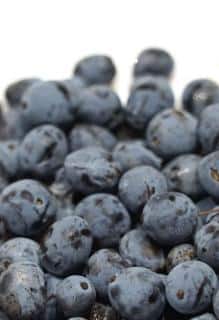Mahonia berries are delicious, tart berries! Learn about how and when to harvest them.
Key Mahonia harvest facts
Harvest season – late fall
Northern Hemisphere: Sept. → Nov.
Southern Hemisphere: Jan. → March
(depends on species, too)
Yield – 4 to 8 pounds (2-4 kg) for a shrub 1 yard/meter wide
Fruit type – berry shrub
Special note – requires bletting
Mahonia berries are best harvested after freezing, with proper attire.
When to harvest mahonia berries
Frost makes fruits sweeter
Mahonia berries are among the fruits that are quite tart until they’ve frozen over.
- Freezing converts tart compounds into sweeter sugars.
- Simply wait for the first frosts to come to the area. After one or two nights, your mahonia berries should be ready for the harvest!
Other fruits that are ready to harvest at the same time include sloes from the blackthorn bush and medlar.
- Bletting is the fact of leaving fruits on trees until they become overripe.
- Fruits that require bletting might turn moldy if left to blet for too long.
How to tell if mahonia berries are ripe
Usually, the berries grow in clusters, just like common grapes.
The right time to harvest is when just a few of the berries have started wrinkling up.
- On a few berries, like one in 10 or 20, skin seems wrinkled up like raisins or fingers during a warm bath.
- Other berries seem plump and full.
- Fruits are all dark violet, almost black in color. Any unripe fruits will still seem pale violet or even green.
- Fruits are rather easily detached from the stems.
- Fruit flesh is tart and your mouth puckers up, but this only lasts around five seconds before a sweeter taste appears.
- Fruit is covered in a waxy, dust-like coat (again, as happens on grapes) but the flesh when opened is a deep reddish-purple.
How to harvest Mahonia berries
Tools
You won’t need much, simply large bowls to collect the harvest in.
- Reduce staining and dribbling juice with water-tight containers that you can close with a lid.
- Don’t overload bowls and containers, or you’ll be bruising the fruits too much.
- Blood-red juice will taint and stain anything it touches. Great for Halloween decorations, though.
As for the harvesting itself, wear thin gloves that will protect your hands from scratching.
- It’s important that your fingers still stay flexible.
The season should already be a tad cold, so wear warm clothes doubled with long-sleeved underclothes, too.
- Provide kneepads or at least a slab of foam to kneel on. This will keep the cold out when harvesting low-hung clusters.
Technique
 Ideally:
Ideally:
- hold the bowl under a bunch of mahonia berries,
- with the other hand, detach berries from the stem in a top-down movement.
- Berries fall in the bowl, voilà!
- The clusters (or racemes on Mahonia eurybracteata) make harvesting particularly easy and pleasurable.
Since there isn’t any commercial production of this fruit, only few specialized devices have been developed that would make harvesting easier. These look like baskets with a rake-like side that collects fruits as you pull the rake portion along the stem.
- Discard any blackened fruits.
- Remove larger stems and leaves.
- It’s ok to leave small fruit-stems, especially you’ll be batch cooking jam and jelly. They’ll be removed with the mahonia seeds together.
It won’t hurt to leave dry, wrinkled fruits in the harvest, but think of the other inhabitants in the garden: leave that food behind!
Leave a few fruits on the tree for birds and animals
Typically, birds and other animals rely on winter fruits and berries during winter.
Remember to leave at least 10 to 20% of the harvest for the birds to eat. Simply leave them on the bush directly.
- Any fruits that fall to the ground are best left there, for the benefit of worms, hedgehogs, and other beneficial animals.
Precautions when harvesting Mahonia berries
Two words of caution: stains & spikes!
Staining juice
- Berry juice stains clothes and fingers!
- It’ll take a day or two for the red hue on your fingers to wash out.
- As for clothes, consider them unsalvageable!
Spiky leaves
This plant isn’t called “grape holly” for nothing – those leaves pack a cat-like scratch!
- Leaves of the Mahonia shrub are spiky and rather tough.
- They’ll scratch your skin.
- Wear thin gloves and long-sleeved (stainable) shirts.
Images: adobestock: Andrii Yalanskyi; own work: Rosalyn & Gaspard Lorthiois; Pixabay: Ulrike Leone

